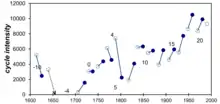Gnevyshev–Ohl rule
The Gnevyshev–Ohl rule (GO) is an empirical rule according to which the sum of Wolf's sunspot numbers over an odd cycle exceeds that of the preceding even cycle[1][2]—see the Figure. The rule breaks down under certain conditions.[3] In particular, it invertes the sign across the Dalton minimum, but can be restored with the "lost cycle" in the end of the 18th century.[4][5] The nature of the GO rule is still unclear.[2]

Illustration of the GO rule: Intensities of sunspot cycles in pairs of even (open circles) and odd (filled circles) numbered cycles.[4] The GO rule is expresses in the connecting lines pointing up. The break of the rule for cycles 2–3 and 4–5 is visible.
References
- Gnevishev, M. N.; Ohl, A. I. (1948). "On the 22-year cycle of solar activity". Astronomicheskii Zhurnal (in Russian). 25 (1): 18–20.
- Hathaway, D. (2015). "The solar cycle". Living Reviews in Solar Physics. 12 (1): 4. arXiv:1502.07020. Bibcode:2015LRSP...12....4H. doi:10.1007/lrsp-2015-4. PMC 4841188. PMID 27194958.
- Komitov, Boris; Bonev, Boncho (2001). "Amplitude Variations of the 11 Year Cycle and the Current Solar Maximum 23". The Astrophysical Journal Letters. 554 (1): 119–122. Bibcode:2001ApJ...554L.119K. doi:10.1086/320908.
- Usoskin, I.; Mursula, K.; Kovaltsov, G. (2001). "Was one sunspot cycle lost in late XVIII century?". Astronomy and Astrophysics. 370 (2): L31–L34. Bibcode:2001A&A...370L..31U. doi:10.1051/0004-6361:20010319.
- Usoskin, I.; Mursula, K.; Arlt, R.; Kovaltsov, G. (2009). "A Solar Cycle Lost in 1793-1800: Early Sunspot Observations Resolve the Old Mystery". Astrophysical Journal Letters. 700 (2): L154–L157. arXiv:0907.0063. Bibcode:2009ApJ...700L.154U. doi:10.1088/0004-637X/700/2/L154. S2CID 14882350.
This article is issued from Wikipedia. The text is licensed under Creative Commons - Attribution - Sharealike. Additional terms may apply for the media files.
